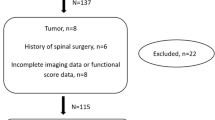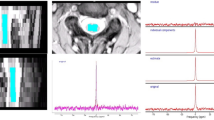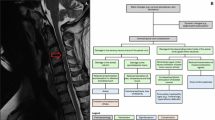Abstract
Study design:
Prospective study.
Objectives:
To assess and quantify Rossolimo reflexes using an electrophysiological test, and correlate the findings with the severity of spinal cord dysfunction in cervical and thoracic spondylotic myelopathy (CTSM).
Setting:
A university neurorehabilitation center.
Methods:
We enlisted 42 patients with CTSM between the fifth cervical and the ninth thoracic cord levels. Using electrophysiological assessments, Rossolimo reflexes were evaluated in all patients. Conduction latencies and amplitude of muscle action potentials (MAPs) of the reflexes were measured, analyzed and compared with the grading of spinal cord dysfunction and the cord compression ratios.
Results:
We found a high diagnostic sensitivity of quantified Rossolimo reflex in patients with CTSM. A positive correlation exists between the MAP amplitude of Rossolimo reflexes and the different grades of spinal cord dysfunction. A negative linear relationship was found between the MAP amplitude of Rossolimo reflexes and the cord compression ratios in CTSM patients.
Conclusion:
Rossolimo reflexes can be measured by electrophysiological assessments, and we demonstrate a quantification method for an established neurological sign. Not only is the Rossolimo reflex found to be a highly sensitive test in clinical neurological examination but the electrophysiological assessment for this reflex can also serve as an objective marker for evaluation of the severity of spinal cord dysfunction in CTSM.
Similar content being viewed by others
Log in or create a free account to read this content
Gain free access to this article, as well as selected content from this journal and more on nature.com
or
References
Campbell WW, DeJong RN, Haerer AF . DeJong's the Neurologic Examination, 6th edn. Lippincott Williams & Wilkins: Philadelphia, 2005, p 493.
Firkin BG, Whitworth JA . Dictionary of Medical Eponyms, 2nd edn. Taylor & Francis: London, 2001, p 347.
Satran R . Chekhov and Rossolimo, careers in medicine and neurology in Russia 100 years ago. Neurology 2005; 64: 121–127.
Madonick MJ . Statistical control studies in neurology, X. relationship between frequencies of reflexes in a group of 2500 non-neurological patients: Babinski, Hoffmann, Rossolimo, Oppenheim, Gordon and absent cutaneous abdominal reflexes. J Nerv Ment Dis 1960; 131: 547–549.
Nurick S . The natural history and the results of surgical treatment of the spinal cord disorder associated with cervical spondylosis. Brain 1972; 95: 87–100.
Shahani BT, Young RR . Human flexor reflexes. J Neurol Neurosurg Psychiatry 1971; 34: 616–627.
Harrop JS, Hanna A, Silva MT, Sharan A . Neurological manifestations of cervical spondylosis: an overview of signs, symptoms, and pathophysiology. Neurosurgery 2007; 60: S14–S20.
Hiersemenzel LP, Curt A, Dietz V . From spinal shock to spasticity: neuronal adaptations to a spinal cord injury. Neurology 2000; 54: 1574–1582.
Nielsen JB, Crone C, Hultborn H . The spinal pathophysiology of spasticity-from a basic science point of view. Acta Physiol (Oxf) 2007; 189: 171–180.
Harrop JS, Naroji S, Maltenfort M, Anderson DG, Albert T, Ratliff JK et al. Cervical myelopathy: a clinical and radiographic evaluation and correlation to cervical spondylotic myelopathy. Spine 2010 (e-pub ahead of print 10 February 2010).
Law Jr MD, Bernhardt M, White III AA . Cervical spondylotic myelopathy: a review of surgical indication and decision making. Yale J Biol Med 1993; 66: 165–177.
Toft E, Sinkjaer T, Espersen GT . Quantitation of the stretch reflex, technical procedures and clinical applications. Acta Neurol Scand 1989; 79: 384–389.
Acknowledgements
We are grateful to Kai-Fong Chang for his technical assistance on the MR imaging of the spinal cords.
Author information
Authors and Affiliations
Corresponding author
Ethics declarations
Competing interests
The authors declare no conflict of interest.
Rights and permissions
About this article
Cite this article
Chang, CW., Chang, KY. & Lin, SM. Quantification of Rossolimo reflexes: A sensitive marker for spondylotic myelopathy. Spinal Cord 49, 211–214 (2011). https://doi.org/10.1038/sc.2010.81
Received:
Revised:
Accepted:
Published:
Issue date:
DOI: https://doi.org/10.1038/sc.2010.81



